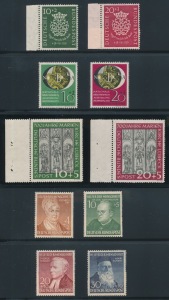German stamps have always been among the most popular of collecting specialties. The German Area is vast philatelically and has typically been broken down into sub-specialties. Few collectors, especially native Germans, attempt it all. The philatelic breakdown is as follows: pre-German Confederation-States collecting, 1870-1930 Empire, and Wiemar Republic, 1930-45 Third Reich, and post 1945 Bundes Republic (in English, Federal Republic). There are many additional subpecialties, such as Colonies or Occupations, but it is by these era divisions that the main country of Germany is usually collected.
The Bundes Bomb
Philately has always been a major hobby in Germany and in all of the German speaking areas. Germans, Austrians, and Swiss have always been the most avid collectors. They have the most detailed and specialized catalogs, the highest quality stamp album producers (in fact four major different publishers produce German hingeless specialty albums), and have the largest and most successful stamp dealers. Their philatelic societies dwarf ours. Philately always was a mainstream hobby with estimates of the adult population collecting being as high as 20% as recently as thirty years ago. What has happened in most of the world to stamp collecting has happened in spades to Germany. Fewer German children have collected in the last thirty years; so now fewer German adults collect. Additionally, the German Federal Post Office has twice demonitzed new issues in the last thirty years— most recently when Germany joined the Euro currency union. Demonetization of postage stamps really hurts philately. Collectors soak up millions of dollars worth of new issues, and when the stamps are no longer usable for postage, they feel ripped off and have bad feelings about their hobby.
This has left modern Germany with a weak market. First, there are fewer collectors, and second, the ones that are left are reticent about putting large sums into a hobby that has seen no growth and which invalidates current postage stamps every fifteen years or so. Making the matter worse is the huge overhang of expensive common post-WWII mint German stamps that there is not enough demand for. Every collection that comes to be sold has the early post war mint German stamps in them, and there just aren’t that many new collectors coming along who need these stamps when they come to market. Baring some catastrophe to the dollar (that pushes up the value of the Euro), these stamps should languish in price for many years.
Fewer collectors means lower prices for common stamps but not necessarily for truly scarcer items. Rare stamps have always been in very short supply, and the degree of scarcity of many rarer stamps is not reflected in the price. This is because most scarcer stamps are sold at auction. One of the paradoxes of auction sale is that though stamps sell to the highest bidder, bidders often have little realization of just how scarce many items are. For example, the post-war German stamps scanned above typically sell about a quarter Scott at auction. Collectors get used to these levels and are reluctant to bid even truly scarce stamps much higher so that while common stamps bring a quarter catalog, many truly rare stamps only bring third of catalog with most bidders dropping out when the stamps get to percentage that they are uncomfortable with.

